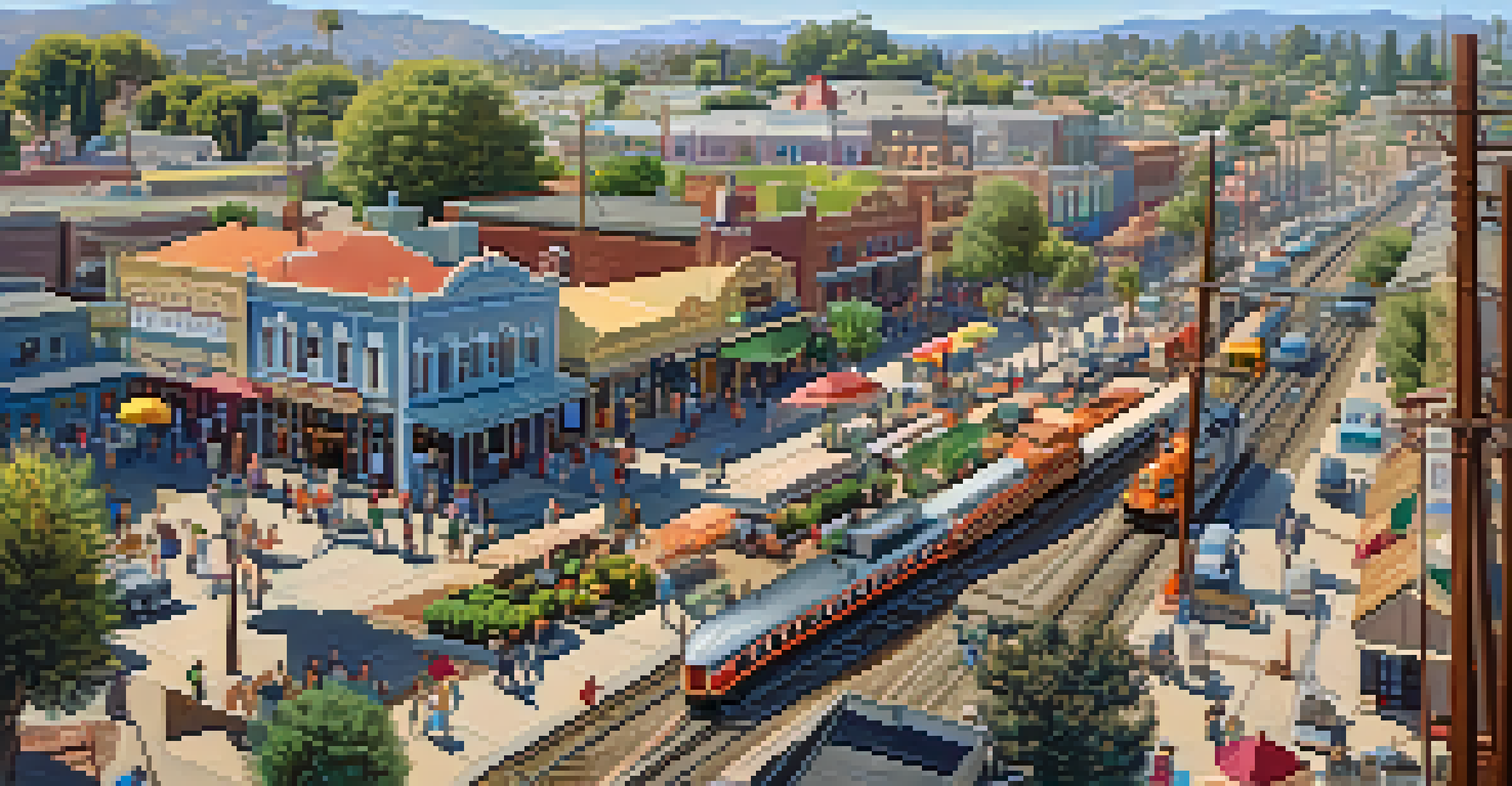The Southern Pacific Railroad: Transforming California’s Landscape

The Birth of the Southern Pacific Railroad
The Southern Pacific Railroad (SP) was established in the late 19th century, emerging as a crucial player in California's transportation landscape. Founded in 1865, the SP aimed to connect the vast and diverse regions of California, facilitating the movement of goods and people. This ambitious project was not just about laying tracks; it was about uniting communities and creating economic opportunities across the state.
The railroad is a great equalizer, bringing communities together and creating opportunities for all.
As the railroad expanded, it faced numerous challenges, including rugged terrain and financial constraints. However, with determination and innovative engineering solutions, the SP overcame these obstacles, eventually stretching from San Francisco to Los Angeles and beyond. This expansion not only enhanced transportation but also fostered trade and commerce, setting the stage for California's economic boom.
The SP's impact was felt far and wide, as it opened remote areas to development. Towns sprang up along the tracks, and agriculture flourished as farmers gained access to broader markets. The Southern Pacific Railroad did more than just connect cities; it helped shape the very identity of California.
Economic Impact of the Railroad
The Southern Pacific Railroad played a pivotal role in revolutionizing California's economy. By providing a reliable transportation network, it facilitated the movement of agricultural products, raw materials, and manufactured goods. This connectivity enabled local businesses to thrive and attracted new industries to the region, significantly boosting economic activity.

One striking example is the agricultural sector, which saw a dramatic increase in productivity and distribution. Farmers could now transport their produce across the state and even to the East Coast, expanding their markets exponentially. This shift not only enriched the farmers but also contributed to California becoming one of the nation's leading agricultural powerhouses.
Railroad Transformed California's Economy
The Southern Pacific Railroad revolutionized California's economy by facilitating the movement of goods, boosting agriculture, and attracting new industries.
Moreover, the railroad opened doors for tourism and real estate development. As scenic routes emerged, travelers flocked to California's stunning landscapes, paving the way for a booming tourism industry. The Southern Pacific Railroad was not merely a transportation line; it was a lifeline for economic prosperity.
Transforming California's Landscape
Beyond economics, the Southern Pacific Railroad transformed California's physical landscape. The construction of the railroad required extensive alterations to the natural terrain, including the creation of tunnels, bridges, and grading of land. This monumental engineering effort changed the way people viewed the state, revealing its beauty and accessibility.
The railroads are the arteries of our country, providing the lifeblood for our economy and culture.
Railroad construction often involved the relocation of rivers and the creation of new pathways, which in turn facilitated urban development. Cities like Sacramento and Fresno expanded rapidly as the SP brought in new residents and businesses. The once-remote areas became bustling urban centers, forever altering California's geography and demographics.
Additionally, the SP contributed to environmental changes, both positive and negative. While it enabled agricultural expansion and urban growth, it also raised concerns about land use and ecological balance. The railroad's legacy is a complex tapestry of transformation—an essential chapter in California's story.
Cultural Impact on Communities
The Southern Pacific Railroad significantly influenced the cultural fabric of California, bringing diverse groups of people together. As the railroad connected distant regions, it facilitated migration, allowing individuals from various backgrounds to settle in California. This influx of cultures enriched the state’s social landscape, contributing to its unique identity.
Communities began to form around railroad stations, fostering a sense of belonging and identity among residents. Celebrations, festivals, and social gatherings often revolved around the railroad, further solidifying its importance in everyday life. The railroad was more than just a means of transportation; it became a symbol of progress and opportunity.
Cultural Impact of the Railroad
The Southern Pacific Railroad enriched California's cultural fabric by connecting diverse communities and fostering a sense of belonging among residents.
However, it’s important to note that the railroad’s expansion was not without controversy. The displacement of Indigenous communities and the impact on local cultures are significant aspects of this history. The Southern Pacific Railroad's story is one of both connection and conflict, highlighting the complexities of California's growth.
Challenges and Controversies
While the Southern Pacific Railroad brought many benefits, it also faced its share of challenges and controversies. The construction and expansion of the railroad often led to conflicts with landowners and Indigenous communities. Many were displaced from their homes, leading to disputes that raised ethical questions about progress versus preservation.
Moreover, the SP's monopoly on transportation services sparked debates about fairness and competition. As the only major railroad in the region, it held significant power over pricing and routes, which sometimes resulted in inflated costs for goods and services. This monopoly led to calls for regulation and oversight, emphasizing the need for balance in economic growth.
These challenges were not merely historical footnotes; they shaped the ongoing dialogue about infrastructure development and community rights. The legacy of the Southern Pacific Railroad is a reminder of the complexities involved in progress, urging us to consider the impact of our choices on both people and the environment.
The Southern Pacific Railroad Today
Today, the Southern Pacific Railroad exists as a crucial part of California's transportation history. While the original SP no longer operates under its name, its legacy lives on through the infrastructure and communities it helped build. Many former SP routes are now used by freight and passenger trains, continuing to connect cities across California.
Moreover, the historical significance of the Southern Pacific Railroad is celebrated in various ways. Museums and heritage railways preserve the stories of the railroad era, educating new generations about its impact on California’s development. These sites serve as reminders of the past while also inspiring future innovations in transportation.
Challenges of Railroad Expansion
The expansion of the Southern Pacific Railroad faced significant challenges, including conflicts with landowners and Indigenous communities, raising ethical questions about progress.
As we look to the future, the lessons learned from the Southern Pacific Railroad's history remain relevant. Discussions about sustainable transportation, urban planning, and community engagement continue to evolve, influenced by the railroad's legacy. The Southern Pacific Railroad may be a chapter in history, but its story still resonates today.
Legacy and Future of Railroads in California
The legacy of the Southern Pacific Railroad is deeply intertwined with the future of railroads in California. Its influence on the economy and culture set a precedent for the role of railways in urban development and transportation. Today, there is a renewed interest in rail travel as a sustainable and efficient mode of transportation, echoing the vision of the SP.
Modern initiatives, such as high-speed rail projects, aim to make California's transportation system more interconnected and environmentally friendly. These endeavors reflect a shift towards prioritizing public transit and reducing reliance on cars, much like the early days of the Southern Pacific Railroad. The goal is to create a more sustainable future while honoring the past.

Looking ahead, the challenges of climate change and urban sprawl demand innovative solutions. The Southern Pacific Railroad's history serves as a guide, reminding us of the importance of thoughtful planning and community involvement in shaping transportation networks. As California continues to evolve, the spirit of the Southern Pacific Railroad will undoubtedly influence its journey.